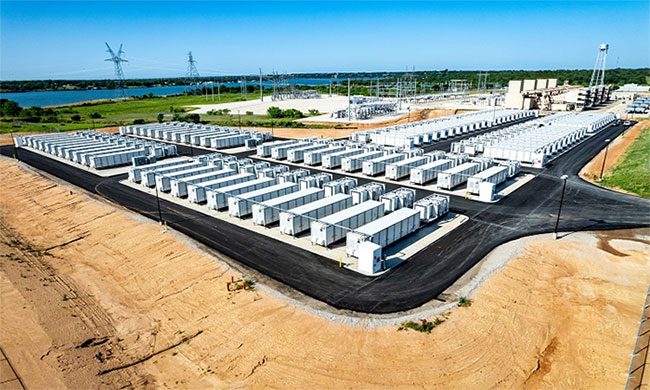Giant Battery Systems Help Offset Power Shortages as Texas Power Plants Unexpectedly Shut Down Due to Overload.
A Heat Dome forming over Texas is exerting unprecedented pressure on the state’s electrical grid, causing authorities to struggle to keep lights and air conditioning running. The oppressive heat is expected to last for several days and could worsen before the heat dome subsides. Some forecasts indicate that temperatures may rise above 100 degrees Fahrenheit in three critical metropolitan areas: Houston, Dallas, and Austin in the coming days. Tens of millions of people in Texas and nearby states are urged to take heat precautions starting June 14, according to the Washington Post.

A giant battery storage facility in Texas. (Photo: PV Magazine)
However, Texas is particularly vulnerable to power outages because it cannot draw electricity from neighboring states during a crisis. This is the only state in the U.S. not connected to the national power grid to avoid federal regulation. “Next week will be a real test,” stated Joshua Rhodes, an energy research scientist at the University of Texas at Austin. “Every air conditioner in the region will need power at the same time.”
State authorities are seeking solutions through giant battery systems. These truck-sized systems can quickly discharge stored electricity into the grid when power plants are struggling, playing a crucial role in preventing blackouts over the past week amid multiple record-breaking temperatures. They also reignite the debate over the role of clean energy in stabilizing Texas’s electrical grid, as batteries are an ideal option for harnessing wind and solar power.
Electricity system operators across the country are closely monitoring how Texas manages this crisis. While Texas is facing prolonged high temperatures combined with overloaded power plants and transmission lines, similar situations could arise in any region at any time. Changing weather patterns and the deteriorating condition of regional power grids make the entire country increasingly susceptible to prolonged outages throughout the year.
“Texas is experiencing what everyone across the country will face in some form over the next few years. All systems were not designed to operate under prolonged heat. This weather can create strange situations that no one has ever thought possible.”
The National Weather Service warns that the prolonged oppressive heat will become increasingly dangerous and potentially deadly in many areas of Texas. The scorching weather is expected to persist into the following week. Cities in Texas are recording numerous shattered temperature records. At San Angelo airport, thermometers peaked at 113.1 degrees Fahrenheit in the middle of the week, far surpassing last year’s record.
High temperatures accompanied by significant humidity exacerbate the effects of the heat and increase health risks. This condition causes heat to be retained in buildings rather than cooling down at night. Along the Mexico border, the situation appears even more severe. The U.S. power grid is under threat as temperatures exceed 100 degrees Fahrenheit in various regions. In Texas, the power grid remains operational despite the extreme heat.
The role of large battery storage in maintaining electricity supply is welcome news for clean energy companies. Battery storage is particularly suited for wind and solar energy as it allows for the collection and storage of generated electricity at times when it is not needed, ensuring availability during peak hours. When a major fossil fuel power plant shut down during peak hours last week amid heat pressure, stored energy from batteries in Texas was quickly dispatched to the grid throughout the evening. The batteries also played an essential role in meeting electricity demand when a nuclear power plant faced issues earlier in the week, according to Doug Lewin, an energy consultant in Texas.
The power grid will quickly face the risk of outages when a power plant unexpectedly shuts down. Batteries, like many gas turbines, can immediately compensate for that lost electricity. This backup power was not available in Texas in 2011 when Winter Storm Uri caused widespread plant failures, leaving millions of Texans freezing in the dark for days. This incident is one of the largest power outages in recent U.S. history, with at least 246 fatalities attributed to the storm. Since then, Texas has become a leader in battery storage in the country, only second to California. Texas plans to double its battery storage capacity within the next five years, which will contribute to the growth of wind and solar energy in the state.


















































